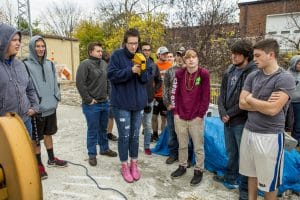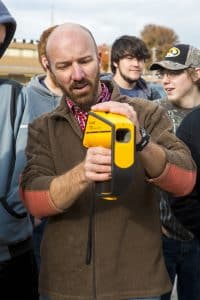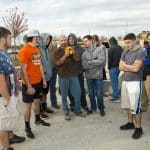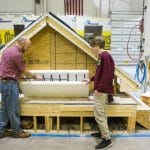For OTC construction technology students, the words “sustainability” and “eco-friendly” are more than just buzzwords ─ they are construction industry standards.
“We need to be smart about how we build,” said Jamie Reeder, a Career Center student at OTC. “We are consuming precious materials we can’t get back, and we need to use them wisely.”
Reeder is a Nixa High School junior and first-semester construction technology student at the OTC Career Center ─ a program that allows juniors and seniors to work toward their high school diploma and a technical degree from OTC simultaneously.
“I love working with my hands,” Jamie said with smile. “I used to be really bored in class all the time. I needed something more hands on. I needed motivation to enjoy school.”
Jamie said she was drawn to a career in the construction industry because she felt she could express herself through her work. She also liked the field’s earning potential.
“I want to own my own construction business and flip houses,” she said. “One of my goals in life is to build my own house the way I want it, where I want it.”
One of Reeder’s elective courses this semester ─ titled Green Building Practices ─ is taught by OTC instructor Justin Frese. The course navigates all aspects of the green construction movement ─ everything from sustainable building materials to green-building techniques and energy-efficient best practices.
“This green shift in the construction industry began about 20 years ago,” Frese said. “And while green construction materials will cost you significantly more upfront, the energy cost savings will offset your initial investment pretty quickly.”
This semester, Frese’s students learned how to install Insulated Concrete Forms (or ICFs) and Structurally Insulated Panels (called SIPs). Both ICFs and SIPs help reduce energy loss, otherwise known as thermal bridging.
“Think of thermal bridging as a super highway of heating and cooling loss,” Frese explained to his class. “Up to 25 percent of the energy lost in a standard frame house is due to thermal bridging.”
To help his students visualize the importance of energy-saving building materials, Frese took his class outside to a small, heated 8×8 shed on a cold November morning. The class met another group of students led by Gene Hoke (he was teaching a congruent section of the same course). The instructors explained to their students that three of the shed’s walls were built with green framing techniques, while one wall was built using a standard frame technique.
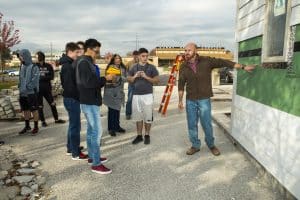
Justin Frese’s Green Building Practices class takes turns viewing thermal bridging through an infrared camera.
The students took turns pointing an infrared camera at the shed. The camera helped students quickly identify which walls were built with green framing techniques. When viewed through the infrared camera, the eco-friendly walls emitted a cool blue color. However, the standard-frame wall emitted a bright red color – students could see exactly where heat was escaping through the standard-frame foundation and roof.
“I love seeing that light bulb go off,” said Frese. “You can see that moment happen when they all of the sudden get it.”
Frese has taught at OTC since 2011. Prior to that, he worked in the construction industry – primarily in remodel and repair. Frese said green construction has always been his passion. He and his business partner would often seek out environmentally friendly projects.
“And my students are passionate, too,” he added. “I’m teaching a woodworking class this semester, and I literally have to kick students out of the shop at the end of the day. It’s so rewarding to see students work hard and love what they do.”


